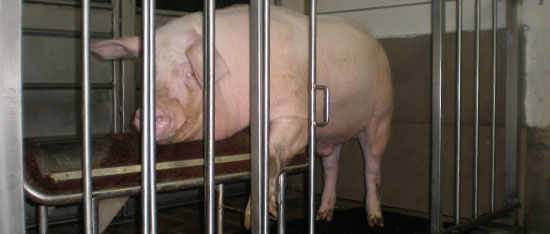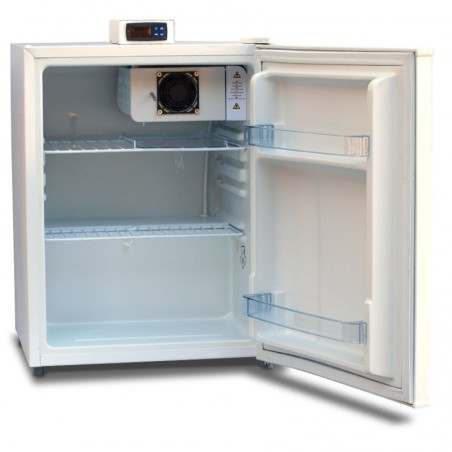The great impact of the boar on the swine production (up to more than 6,000 piglets produced by boar and year) determines the great interest in the study of any factor that can have an incidence on its production results. The feeding can, in some cases, be decisive for the sexual behaviour of the boars (libido, difficulties during mountings, longevity, amount and quality of the semen, etc.).
The energy requirements in order to satisfy the different needs for the maintenance, the growth, the mounting activity, the semen production and the thermoregulation have been described perfectly:

| Daily energy requirements for a productive adult boar | |
| Maintenance | 182 kcal ME x LW0.665 |
| Protein deposition | (5.68 kcal ME x P)/0,54 |
| Fat deposition | (9.49 kcal ME x F)/0,74 |
| Mounting activity | 4.3 kcal ME x LW0.75 |
| Semen production | 103 kcal ME |
| Thermoregulation | (3.82 kcal ME x LW0.75) x (Tc-T) |
LW = live weight in kg; P and F = deposition of protein and fat, respectively, in grams per day; and Tc and T are, respectively, the critical temperature (20ºC) and the environmental temperature.
Close and Cole, 2000
The protein requirements for an adult boar are relatively low:
| Daily protein requirements for a productive adult boar | |||
| g / day | % in the compound feed (2.6 kg/day) | % in the compound feed (3.0 kg/day) | |
| Protein | 260 | 10 | 8.68 |
| Lysine | 12 | 0.46 | 0.4 |
| Methionine | 4.2 | 0.16 | 0.14 |
| Methionine + cysteine | 8.4 | 0.32 | 0.28 |
| Threonine | 10 | 0.38 | 0.33 |
| Tryptophan | 2.4 | 0.09 | 0.08 |
| Histidine | 3.8 | 0.01 | 0.13 |
| Isoleucine | 7 | 0.27 | 0.23 |
| Leucine | 10.2 | 0.39 | 0.34 |
| Phenylalanine | 5.7 | 0.22 | 0.19 |
| Phenylalanine + tyrosine | 11.4 | 0.44 | 0.38 |
| Valine | 8 | 0.31 | 0.27 |
Adapted from Nutrient requirements of swine, NRC 1998
At a practical level, with a consumption of between 2.6 and 3.0 kg for boars of between 200 and 300 kg live weight, we will need a compound feed with 3,000 kcal ME/kg, and a 0.5% of digestive lysine will be enough.
| Vitamin requirements for the boar | |||
| NRC (1) | DSM (2) | BASF (3) | |
| Vit A, IU/kg | 4,000 | 15,000 | 20,000 |
| Vit D, IU/kg | 200 | 2,000 | 2,000 |
| Vit E, mg/kg | 44 | 80 | 160 |
| Vit K, mg/kg | 0.5 | 2 | 2 |
| Vit C, mg/kg | - | - | 150 |
| Vit B1, mg/kg | 1 | 2 | 2 |
| Vit B2, mg/kg | 3.75 | 9 | 7 |
| Niacin, mg/kg | 10 | 45 | 40 |
| Pant. acid, mg/kg | 12 | 25 | 16 |
| Vit B6, mg/kg | 1 | 5 | 6 |
| Vit B12, ug/kg | 15 | 30 | 30 |
| Biotin, ug/kg | 200 | 500 | 300 |
| Folic acid, ug/kg | 1,300 | 5,000 | 3,000 |
(1) Nutrient requirements of swine, NRC 1998
(2) Optimum vitamin nutrition of the animals for the production of quality foods, 2002
(3) Technical informations, BASF 2001

Landrace boar in an artificial insemination centre
Apart from satisfying the basic nutritional needs, we must highlight the key functional aspects to be improved in the breeding and their possible relationship with nutrition:
Improvement of the poise: The poise problems can be the main cause for the lack of libido and the inability of the boar for mounting, as well as causing a high percentage of culling due to lameness problems.
We must control, periodically, the body condition of the boars and establish a food restriction if necessary in order to avoid overweight boars.
It is important to maintain an optimal Ca/P relationship for a correct bone mineralization (Ca/P relationship of between 1.3 and 1.5:1), a minimum of Ca of between a 0.75 and a 0.95%, and a minimum of Mg of 400 ppm. Adequate levels of vitamin D are important in order to facilitate the absorption of Ca and P, and it is important that part of this vitamin is given in the form of 25-OH-cholecalciferol, which will facilitate its bioavailability, especially in the case of the older adult males, because it avoids going through the liver, that is sometimes overloaded. We must provide an adequate electrolytic balance, avoiding the acidification of the medium, which would hinder the correct deposition of calcium in the bones.
Adequate levels of biotin will guarantee the integrity of the horn-like tissue of the hoofs.
Libido: The thyroid hormone regulates the basal metabolism and it affects the breeding, specifically. A decrease in the thyroid function entails a lack of libido and a decrease in the semen quality. It is advisable to include iodine in the diet (0.5-0.8 mg/kg) and to avoid the presence of antinutritional factors (as, for instance, the glucosinolates in the rapeseed) that may hinder the iodine fixation to the thyroid hormones.

A decrase in the testoterone levels in the blood also entails a lack of libido. The biosynthesis of the steroid hormones is carried out from cholesterol, which is, in turn, synthesized in the liver, and that can become altered by the presence of certain mycotoxins. Also, zearalenone interferes in the normal spermatogenesis process, reducing the synthesis of testosterone. So, we must avoid the presence if micotoxins in the compound feed, including effective chelating agents, if necessary.
Sperm quality: Zn has an important role in the spermatogenesis and in the maturation process of the Leydig cells, which are responsible for the testosterone synthesis. It is convenient to add Zn (100 ppm), a part of it preferebly in the form of a chelate in order to avoid any interaction with other minerals during its intestinal absorption.
A hypovitaminosis A affects the germinal cells, and this leads to a decrease in the quality of the semen. A adequate inclusion of vitamin A in the compound feed is recommendable.
The 70% of the fatty acids in the seminal plasma and in the sperm are polyunsaturated fatty acids whose oxidation is very easy. The inclusion of effective doses of vitamin E, vitamin C and selenium, as well as natural polyphenols, in the compound feed, is helpful towards the maintenance of the integrity of the sperm membranes. With low selenium levels, the sperm motility is reduced and the abnormal sperm are increased, and this entails a decrease in the fertility.
In the seminal fluid we can detect high concentrations of prostaglandins (100-300 µg/ml), produced, mainly, by the seminal vesicles. A good content of polyunsaturated fatty acids in the diet is advisable, because they are the precursors of the prostaglandins. An extra intake of omega-3 fatty acids is advisable in order to keep an n-6:n-3 ratio lower than 5-6:1.
Ejaculate volume: The supplementation with vitamin B6 and folic acid improve the semen production and the proportion of motile sperm cells. The sulphur-containing amino acids play an important role on the secretory activity of the epididymis.
In the feeding of the boars it is important to pay attention to the quality of the ingredients used and endeavour to obtain a correct reproductive functionality.





